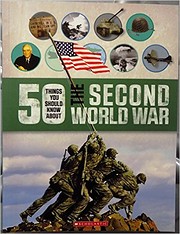

Pulse en una miniatura para ir a Google Books.
|
Cargando... The Second World War (50 Things You Should Know About)por Simon Adams
 Ninguno Actualmente no hay Conversaciones sobre este libro.  Like the analogously named book about World War I, this small book is replete with excellent maps, great photos, fascinating fact-boxes, and reader-friendly infographics. But of course, limiting a vast subject like “World War II” to “fifty things” is going to leave some gaps. Perhaps the most significant omission to my mind is the matter of the internment of Japanese Americans in the United States. This involved the forced relocation and incarceration in 1942 of between 110,000 and 120,000 people of Japanese ancestry, 62% of whom were U.S. citizens. Men, women, and children were sent to camps in barren, inhospitable locations. As many as 25 persons lived in spaces intended for four. Their belongings, businesses, and savings were confiscated. (Losses were estimated by the government as more than $200 million in 1942.) None were ever found guilty of disloyalty; a 1980 U.S. Government Commission concluded the incarceration had been the product of racism. Similarly, Britain’s roundup of Italians and Germans (including Jewish citizens from those two countries who had fled to Britain to avoid the Nazis) gets no mention whatsoever. The author includes a “blurb” on the 1944 Warsaw Uprising of the Polish Resistance, but nothing whatsoever about the 1943 uprising of the Warsaw Jewish Ghetto, one of the more amazing acts of resistance in modern history. [You can read a summary of what happened here.] Nor is there any mention of The Katyn massacre, a series of mass executions of Polish nationals carried out by the Soviet secret police in 1940, and only acknowledged by Russia in 1990. (Churchill and FDR both knew about what happened at Katyn, but chose not to criticize their Soviet ally.) Another omission seemed unfortunate to me. Although the author devotes a relatively large section to the British code breakers of Bletchley Park and Alan Turing, it is a shame he did not take the opportunity to report on how the British government “rewarded” Turing for work acknowledged as “essential” in defeating enemy U-boats and helping the Allies at D-Day. (In fact, by some accounts, it has been estimated that the work at Bletchley Park shortened the war in Europe by as many as two to four years. And yes, the post-war world does receive some coverage, so it cannot be said to be outside of the purview of the work.) Turing was prosecuted in 1952 for homosexuality; forced to undergo chemical castration in lieu of imprisonment; and died of cyanide poisoning in 1954 (whether self-induced or not has never been conclusively established). Nevertheless, the author found many ways to include engrossing aspects of a huge subject as well as some “fun facts” (like the derivation of code names for various military operations) and gives a good, if incomplete, overview of what happened during the war. Importantly, I don’t think anyone is going to be bored by the history lessons in this book. Evaluation: This book does a very good job at introducing the subject of World War II to students. All the eye-popping pictures and facts will no doubt inspire further inquiries, at which time the omitted portions of the history will become clear. Great maps and infographics with plenty of photos will make the time fly as you learn the basics. A brief “who’s who” photo gallery and glossary are at the back of the book. sin reseñas | añadir una reseña
Pertenece a las series
Discover what caused the war and why it eventually affected every corner of the globe. This text explores key battles, events and figures. No se han encontrado descripciones de biblioteca. |
Debates activosNingunoCubiertas populares
 Google Books — Cargando... Google Books — Cargando...GénerosSistema Decimal Melvil (DDC)940.53History and Geography Europe Europe 1918- World War IIClasificación de la Biblioteca del CongresoValoraciónPromedio: (4.5) (4.5)
¿Eres tú?Conviértete en un Autor de LibraryThing. |
||||||||||||||||||||||||||||||||||||||||||||||||||||||||||||||||||||||||||||||||||||||||||||||||||||||||||||||||||||||||